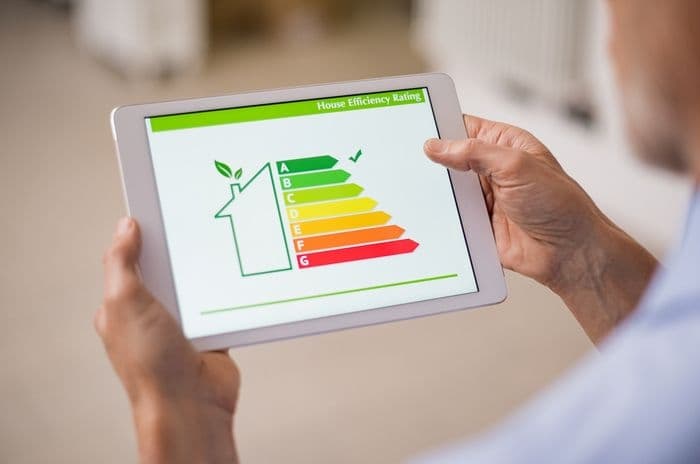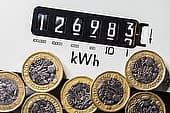Big ticket changes like adding or improving home insulation, installing double-glazing or getting a new boiler make the biggest difference to energy efficiency.
Cheaper options like draught proofing and switching to more energy efficient appliances can also have an impact on bills when taken together.
Customers should also consider monitoring their energy usage through their smart meters or energy monitors to keep track of what's costing the most money.

1. Home insulation
Good insulation is an energy efficiency must, and as such there have been more grants for this home improvement over the years than for any other energy efficiency saving.
Even those who pay for it themselves, partly or in full, are likely to get good value for money - but it will take time to see a return.
The most efficient homes will have all of the following forms of insulation:
- Roof and loft: 250mm to 270mm insulation
- Walls: cavity or internal/external proofing
- Windows: double glazing and draught proofing
- Flooring: sealing draughts and underfloor heating
Windows should also be double glazed and draught proofed for maximum insulation benefits - we go into that later.
Here are estimates on the amount customers could save on their energy bills each year from various insulation measures. We go into more detail about the installation costs in the individual sections below.
| Roof and loft insulation | Cavity wall insulation | Solid wall insulation | Floor insulation | |
|---|---|---|---|---|
| Detached house | £25-£380 | £310 | £425 | £85 |
| Semi-detached house | £15-£165 | £185 | £255 | £50 |
| Mid-terrace house | £14-£150 | £120 | £160 | £35 |
| Bungalow | £20-£235 | £125 | £170 | £75-£80 |
| Mid-floor flat | N/A | £95 | £125 | N/A |
Note: Figures taken from Energy Saving Trust estimated savings per year for homes in England, Scotland and Wales. Separate estimates are available for Northern Ireland. All figures below are taken from Energy Saving Trust data available at the time of writing.
Roof and loft insulation
| Annual savings if insulated from 0mm to 270mm | Cost of installation | |
|---|---|---|
| Detached house | £380 | £395 |
| Semi-detached house | £165 | £300 |
| Mid-terrace house | £150 | £285 |
| Detached bungalow | £235 | £375 |
Approximately a quarter of all heat lost from an uninsulated house is through the roof, so it's well worth getting insulation installed to keep our homes warmer and save money on energy bills.
Roof and loft spaces are insulated with mineral wool and if a loft is easy to access and has no damp problems, it's possible for homeowners to install themselves.
There are other types of loft insulation material that may be more expensive to install, so be sure to get complete quotes before making a decision.
The figures in the table above are based on insulating a completely uninsulated loft by adding 270mm of insulation.
As the table shows, the initial outlay on this type of insulation can easily be recouped by homeowners after one to three years and would therefore be worth the cost for most people.
It's also possible to boost loft insulation if there's only currently 120mm in there already, and the Energy Saving Trust have estimates for this too:
| Annual savings if insulated from 120mm to 270mm | Cost of installation | |
|---|---|---|
| Detached house | £25 | £290 |
| Semi-detached house | £15 | £235 |
| Mid-terrace house | £14 | £230 |
| Detached bungalow | £20 | £280 |
The benefits from boosting insulation are much lower and will take longer to recoup. However, it may be worthwhile if homeowners are having multiple insulation measures installed at once and the costs of professional installation are lower.
Wall insulation
In uninsulated homes, around a third of all heat lost is through the walls.
Homes built within the past 30 years or so will already have wall insulation, but for houses older than this it's a beneficial option to consider.
There are two types of wall in most UK houses:
- A cavity wall: made up of two walls with a gap in between.
- A single wall: a solid brick or stone wall with no cavity - generally found in houses built before 1920.
As solid walls let out twice the heat as cavity walls, getting solid walls insulated will save a considerable amount on energy bills. However, the initial outlay for the insulation is much higher for solid walls than for cavity walls.
Both these measures need to be professionally installed and estimates can vary drastically from one company to another, so be sure to get a few quotes and understand exactly what is being offered.
Here's a closer look at what they can deliver.
Cavity walls
| Annual savings | Cost of installation | |
|---|---|---|
| Detached house | £310 | £610 |
| Semi-detached house | £185 | £475 |
| Mid-terrace house | £120 | £390 |
| Detached bungalow | £125 | £460 |
| Mid-floor flat | £95 | £345 |
Typically, the cost of cavity wall insulation can be recouped in two to three years and so will be worth the outlay for most homeowners.
Solid walls
| Annual savings | External wall | Internal wall | |
|---|---|---|---|
| Detached house | £425 | £10,000 | £8,200 |
| Semi-detached house | £255 | £10,000 | £8,200 |
| Mid-terrace house | £160 | £10,000 | £8,200 |
| Detached bungalow | £170 | £10,000 | £8,200 |
| Mid-floor flat | £125 | £10,000 | £8,200 |
The costs of installing solid wall insulation are much higher and this is mainly because many homeowners look at doing the entire house at the same time to limit disruption.
However, having wall insulation installed at the same time as doing other home improvements such as fitting a new kitchen or bathroom can help reduce costs.
Solid wall insulation is unlikely to be a quick fix for a home due to the financial outlay involved, but those who can afford it should consider it. As well as providing energy bill savings and reducing carbon emissions in the short term, it will help to boost the home's energy rating ahead of selling or renting it out.
Floor insulation
| Annual savings | Cost of installation | |
|---|---|---|
| Detached house | £85 | £520-£1300 |
| Semi-detached house | £50 | £520-£1300 |
| Mid-terrace house | £35 | £520-£1300 |
| Bungalow | £75-£80 | £520-£1300 |
Although not the biggest cause of heat loss in the home, it's still worth considering floor insulation to save an average of £50 per year on energy bills.
These outlays can be seen as having long term benefits, with it taking many years to recoup the costs. However, taken in tandem with other insulation measures (if installed at the same time), the cumulative effects could make it worthwhile.
Underfloor insulation varies by type of flooring - most homes have floorboards or concrete floors, or a combination of both - and will cost more than DIY draught sealing, particularly if a professional is hired to do the work.
Gaps between skirting boards and flooring can cause draughts, but these gaps can usually be sealed fairly easily by homeowners without having to call in a professional.
As such the outlay for sealing these gaps should not be very high - essentially just the cost of buying a tube of sealant.
Paying for insulation
Many people can afford to insulate their homes without help, but there are grants available for wall and roof insulation through the Energy Company Obligation (ECO3) scheme for those on a low income.
ECO3 has more stringent criteria than previous schemes and it is targeted towards the poorest and coldest households.
Large energy suppliers are required to have an ECO3 scheme available and to install a certain number of measures for customers. However, some of these schemes are closed for new applicants.
For more information about ECO3, read our guide to guide to funding home insulation.
2. Windows
Double-glazed windows have two sheets of glass that are typically 16mm apart. This creates an insulating area of air between the two panes that helps to keep heat in.
Most modern homes are built with double-glazing as standard, but for homes that are completely single-glazed there are considerable savings to be made.
The Energy Saving Trust suggests that installing A-rated double-glazing in a semi-detached gas heated home with single-glazing would save £95 per year. Installing A++ rated double-glazing to that same home would save £115 per year.
However, the cost estimates they put forward are high and differ depending on the materials used:
- Set of A-rated PVC windows for a semi-detached house - £4,250
- Set of A-rated hardwood windows for a semi-detached house - £15,000
It's hard to predict the cost of installing double-glazing as this will vary by the number and size of windows that need to be worked on.
But despite the cost, for most modern households double-glazing is seen as an absolute must in order to keep heat in and save on energy bills, particularly when we consider that it easily lasts for 20 years.
Draught proofing
Another way to keep the heat in around windows and other openings is to take measures to draught proof our homes.
Draughts can be found around windows and any other opening or cavity through which draughts can enter the home and warm air can escape, for example around pipework and wall joints.
Getting a professional to assess and comprehensively draught proof a home can cost around £200 according to the Energy Saving Trust, with an estimated annual saving of £30.
Carrying out some DIY draught proofing jobs will reduce the initial outlay for homeowners.
However, getting a professional in may save more money in the long run. This is because professionals are more easily able to assess which areas need draught proofing and will more comprehensively draught proof a house to reduce overall heat loss.
3. Lighting and heating
The average UK home spends around 15% of their energy bill on lighting.
To reduce money spent on lighting, use the best energy saving light bulbs throughout the home.
There are two types of energy efficient bulb in the UK: compact fluorescent lamps (CFLs) and light emitting diodes (LEDs).
Changing from a traditional light bulb to one of these will save around £3 to £6 per year per bulb, and changing to LED lights throughout the home saves around £35 per year on electricity bills.
However, for those who really want to make savings on energy and bills, it isn't lighting but heating that will help cut usage and costs.
Typically, around 60% of a household's energy bill comes from the boiler alone.
Newer boilers tend to be more efficient and have more user-friendly controls, enabling households to make further savings.
As such, for anyone with a boiler that's less than 10 years old there's not much point to replace it, as it will already be efficient and the savings won't amount to much.
Also, replacing a boiler is very expensive, with the average cost of a boiler and installation standing at around £2,500 according to the Energy Saving Trust.
But it can be worth the expense for households with an older, more inefficient boiler, particularly for people who have a mains gas connection to their house.
Here are some Energy Saving Trust examples of how much households could save per year by upgrading an old gas boiler to a new A-rated condensing boiler with a programmer, room thermostat and thermostatic radiator controls (TRVs):
| D-rated | E-rated | F-rated | G-rated | |
|---|---|---|---|---|
| Detached house | £165 | £205 | £255 | £365 |
| Semi-detached house | £135 | £150 | £170 | £240 |
| Mid-terrace house | £115 | £130 | £145 | £205 |
| Detached bungalow | £105 | £120 | £135 | £190 |
| Mid-floor flat | £50 | £60 | £65 | £95 |
Upgrading from the more inefficient boiler can mean that a new installation pays for itself over a decade, but savings are likely to be more modest.
However, boilers break and need to be replaced, so this might be an energy efficiency measure that occurs naturally and has to be done rather than a deliberate choice on the part of a homeowner or landlord.
Read more about the cheapest ways to get a new boiler.
5. Home appliances
Home appliances make up a fairly large proportion of household energy use and, consequently, efficiency differences between models are worth taking into account.
Appliances include large white goods like fridge-freezers and washing machines, as well as smaller items like televisions and computers.
These days, we're used to seeing energy efficiency labels on our appliances, although these have changed in recent years to stop the proliferation of A+, A++ and A+++ ratings that can add extra confusion for customers.
Instead, the ratings are simply A to G, with A-rated appliances the most energy efficient and so those will save customers more money on their energy bills.
Read about which appliances cost the most to run and what to look out for.
Plus, taking appliances off standby can save a household £40 per year, so it's worth switching everything off at the plug rather than leaving it idle.
6. Smart meters
A useful way to actively monitor energy use is with a smart meter.
The aim is for 85% coverage of each energy supplier's customers by the end of 2025, so customers will be encouraged to allow one to be installed. These smart meters are supplied by energy companies and are completely free to households.
The meters have digital display panels that allow households to actively monitor their energy consumption and take measures to reduce it, if needed.
For households with a smart meter there are also no more estimated energy bills because all energy usage is monitored in real time and the information is sent wirelessly to the energy supplier.
Although it's worth remembering that this only works if households regularly check their meters and proactively take steps to reduce the energy use displayed on them.
7. Changing behaviour
Becoming more energy efficient is undoubtedly worthwhile. But it's hard to quantify the savings that can be made, because this depends not only on the measures listed above but on how far a household optimises energy efficiency in the first place.
So far we haven't discussed how changing our behaviour can save energy - except in the case of using smart meters to monitor energy use.
Some examples of simple changes that can be made to save energy include:
- Washing clothes at 30 degrees rather than 40 degrees
- Taking shorter showers - ideally no more than 10 minutes
- Not keeping the oven or fridge door open for long periods
- Drawing curtains in the evening to keep warmth in
- Turning the thermostat down by one degree
These small acts can add up and, by using smart meters or energy monitors to keep track of our usage, we can personally see if they're making a difference in our homes.
Summary: plenty of energy saving options
There are many options for improving the energy efficiency of a home, although it's the bigger ticket measures such as new insulation or replacing their boiler that can have the greatest impact.
Understandably, many homes will not be able to afford those measures and, if they can't get access to help from Government or other schemes, they might have to focus on smaller measures first.
Replacing appliances with more energy efficient options, monitoring usage through a smart meter and making sure draughty doors and floorboards are fixed can each make a small difference to our bills - and those small differences add up.
For those looking beyond the energy efficiency of their own home and considering what steps they can take to improve the carbon footprint of the energy they use, take a look at our guide to green energy tariffs.









Comments